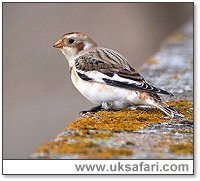
|

|
|
 Sent
to you Sent
to you
by e-mail
|
|
Simply
enter your details and hit the send button
more
info |
|


Click Here

Links
Advertise
Terms of Use
Contributors
About Us
Contact Us
|
 |
Go back
 | Bookmark
| Bookmark
 | Print Page
| Print Page  | E-Mail Us
| E-Mail Us 
 Digital Bird Photography
Digital Bird Photography
by Steve Botham
 Photo: Steve Botham
Photo: Steve Botham
|
|
UK Safari Tip:
You can get great discounts on digital cameras and accessories at Amazon.co.uk -
click
here
|
|
I've been using a 'Nikon 995' for two years now without the need for extra lenses,
and have acquired some very good results in the field
'Digi photography', or 'digiscoping as
its now known has taken the Birding world by storm. Almost all birders are now carrying some make of Digital camera with them on their days
out. The fixed lens
versions are the best, as there is no lens zooming in and out. It's all done
internally. Prices start from about £200.
The scope I use is a Swarovski AT80 HD, with a 20-60 Zoom. I never use the zoom facility on the eye piece for taking pictures, I always keep it on 20x. A fixed 20x lens gives crisper pictures and they afford a better field of view than Zoom lenses.
When buying a Scope the main things to look for are a large objective lens,
ideally 70mm or above (for brighter images) and a fixed eye piece of around 20x.
Most importantly, the Scope needs to be angled. The straight through scopes are to difficult to use for Digital photography. You need the scope set up around chest level, as this is the most comfortable position for using the camera.
Before you buy a scope try it out. Most decent shops will expect you to do this.
You can buy adaptors which physically link the camera
to the eye piece of the scope. I've tried these on my Coolpix, but found them
very fiddly, and I was forever taking it on and off to locate the Bird. I now hand hold the Camera to the eye piece. This takes a little practice but is much faster and allows you to quickly look through the scope and re-adjust the focus if necessary.
Most makes of Digital camera
can be switched to wide angle or just zoomed down. They then come into their own,
as there’s no need to change lenses. The Nikon will do Macro shots down to
2cm, or wide angle shots to 32mm, which is ideal for plants and flowers.
Of course the big advantage of digital photography over film photography is that
you can view your pictures immediately on the monitor and delete any unwanted
shots. How many times have you had a film processed only to find they are
virtually all out of focus or not quite how you wanted them framed? With Digital
this is no longer a problem. Loading them onto a computer is a breeze and you can view
them full screen size, or send out to your friends via e-mail.
Most digital cameras take some
form of 'memory stick' or 'Flashcard'. These come in various sizes from 8Mb up to
2GB. I use 256Mb flashcards which cost about £30 off the Web. These hold around
160-240 pictures, on the best setting
on the camera, depending on how complicated the picture is.
When the
birding is slow I turn to other forms of wildlife photography. In a single day’s outing I have taken several shots of birds, then switched
to Butterflies and Dragonflies, Plants, Fungi then finished off in the evening
with a few Moth shots in my garden, I've collected more quality pictures of wildlife
in the past two years with my Nikon than I ever got in 10 with my old 35mm camera.

UK Safari Photography Section
|
 |

|